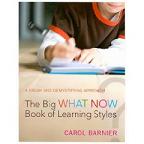The Big WHAT NOW Book of Learning Styles by Carol Barnier

Review by Kathy Kuhl
Different children learn differently. Many authors have described these differences and shown us how to figure out our children’s learning styles. But homeschoolers always want to know, “How do I apply this theory to my homeschool? What now?” In her latest book, The Big WHAT NOW Book of Learning Styles, Carol Barnier provides hundreds of suggestions for multi-sensory instruction that are easy and fun. As always, Carol’s practical advice is sprinkled with good sense and humor. Her goal is “to simplify the process, and to put delight and fun back into learning.”

As Carol points out in Chapter One, “Why Another Book on Learning Styles?”, the business of labeling children by learning style can cause problems. It can confuse us. Many books, Carol says, “are long on diagnosis and short on prescription.” Some give prescriptions that are too broad to be useful. A diagnosis is not helpful, Carol says, if it leads us only to “exchange a new boxed-in idea of how this child should learn for the old boxed-in idea we just abandoned.” Our assumptions about how our children learn best can keep us from exploring new methods that might help. For example, Carol explains that because her son couldn’t keep to a beat in music, she assumed chants and rhythm would not help his memory. She was surprised to see he loved rhythmic ditties and them helped him remember. She encourages parents to experiment with different approaches.
Chapters Two through Four lay the foundation of Carol’s book. She describes the frustration of children and parents who have not found the keys to how each child learns. Rather than letting the child think he or she is defective, she says we need to keep trying “keys”—exploring new techniques—until we see what works and is fun for this child. Parents need to “develop the ability to take any learning activity and find ways to incorporate many different teaching approaches.”
Sound daunting and time-consuming? Carol explains that spending time finding the strategy that helps your child learn is much less time-consuming that spending months on methods that don’t work. This emphasis on finding the right methods also takes the burden off the child: it’s not the child who is defective, it’s just the wrong teaching approach for this child. In Chapter Four, “How To Use This Book,” Carol completes her foundation by stressing that parents must keep trying a variety of ways to address all learning styles, not squeezing their child into one category. By this she doesn’t mean infinite amounts of work for the parents, but an open-minded approach to different multi-sensory methods that will make learning more fun.
After the four foundation chapters, we move to the bulk of the book. Carol breaks her chapters by subject, totaling 128 pages crammed full of easy-to-do, engaging ideas for teaching, including many ideas good for older students:
- Spelling
- Writing (both handwriting and composition)
- Reading
- Math
- History
- Geography
- Science
- Reviewing material in any subject
The final chapter, “Things Your Children Wish You Knew About How They Learn,” is one of my favorites. It covers many common, but incorrect assumptions parents and teachers make about how our children learn. For example, it reminds us not to confuse slow with stupid, and to remember that some students must move to learn. The chapter provides basic tips for working with children with memory and processing problems, and reminds us to accept creative answers from our children.
Carol concludes by showing us how and why to praise our children’s work more than we criticize it. She reminds parents that we must believe in our children, or they won’t believe in themselves. Some friends are practical, some are wise, and some are funny. Carol Barnier is all three. I think you will find this a helpful book. Want to learn more?
Click here to learn more or to buy this book from Amazon. Thank you.

